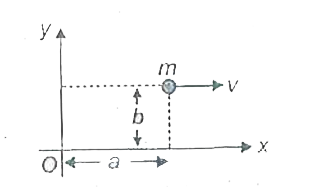Statement - 1 : A particle moves with a constant velocity parallel to the x-axis. Its angular momentum w.r.t. the origin will remains constant.
Because
Statement - 2 : Angular momentum is defined as →L=→r×→P
Statement - 1 is true, statement - 2 is true, statement - 2 is correct explanation for statement - 1
Statement - 1 is true, Statement - 2 is true, Statement - 2 is not a correct explanation for statement - 1
statement - 1 is true, statement - 2 is false
statement - 1 is false, statement - 2 is true.
The correct Answer is:A
To solve the question regarding the statements about angular momentum, we will analyze each statement step by step.
Step 1: Understanding Statement 1
Statement 1 claims that a particle moving with a constant velocity parallel to the x-axis has a constant angular momentum with respect to the origin.
- Analysis:
- A particle moving with a constant velocity means that its linear momentum is constant.
- The angular momentum →L of a particle with respect to a point (in this case, the origin) is given by the formula:
→L=→r×→P
where →r is the position vector from the origin to the particle, and →P is the linear momentum of the particle.
Step 2: Understanding Statement 2
Statement 2 states that angular momentum is defined as →L=→r×→P.
- Analysis:
- This is indeed the correct definition of angular momentum.
- The position vector →r is the distance from the origin to the particle, and →P is the momentum of the particle, which is given by →P=m→v (where m is mass and →v is velocity).
Step 3: Evaluating the Statements
- Since the particle is moving parallel to the x-axis with constant velocity, the position vector →r changes in time but the direction of →P remains constant (as both are parallel).
- The angular momentum →L will remain constant because the cross product →r×→P will not change in magnitude or direction as long as the particle moves along the x-axis and the origin remains fixed.
Conclusion
- Statement 1 is correct: The angular momentum remains constant.
- Statement 2 is also correct: It correctly defines angular momentum.
Thus, both statements are true, and Statement 2 is a correct explanation of Statement 1.
Final Answer
Both statements are correct, and Statement 2 is the correct explanation for Statement 1.
Statement 1 claims that a particle moving with a constant velocity parallel to the x-axis has a constant angular momentum with respect to the origin.
- A particle moving with a constant velocity means that its linear momentum is constant.
- The angular momentum →L of a particle with respect to a point (in this case, the origin) is given by the formula:
→L=→r×→P
where →r is the position vector from the origin to the particle, and →P is the linear momentum of the particle.
Statement 2 states that angular momentum is defined as →L=→r×→P.
- This is indeed the correct definition of angular momentum.
- The position vector →r is the distance from the origin to the particle, and →P is the momentum of the particle, which is given by →P=m→v (where m is mass and →v is velocity).
- Since the particle is moving parallel to the x-axis with constant velocity, the position vector →r changes in time but the direction of →P remains constant (as both are parallel).
- The angular momentum →L will remain constant because the cross product →r×→P will not change in magnitude or direction as long as the particle moves along the x-axis and the origin remains fixed.
- Statement 1 is correct: The angular momentum remains constant.
- Statement 2 is also correct: It correctly defines angular momentum.
Both statements are correct, and Statement 2 is the correct explanation for Statement 1.
Topper's Solved these Questions
- BOOK - FIITJEECHAPTER - ROTATIONAL MECHANICSEXERCISE - ASSIGNMENT PROBLEMS (OBJECTIVE ) LEVEL - II16videos
ROTATIONAL MECHANICS
- BOOK - FIITJEECHAPTER - ROTATIONAL MECHANICSEXERCISE - COMPREHENSION - III1videos
ROTATIONAL MECHANICS
- BOOK - FIITJEECHAPTER - ROTATIONAL MECHANICSEXERCISE - ASSIGNMENT PROBLEMS (SUBJECTIVE ) LEVEL - II & III15videos
ROTATIONAL MECHANICS
- BOOK - FIITJEECHAPTER - PHYSICS PART2EXERCISE - Numerical Based Question Decimal Type6videos
PHYSICS PART2
- BOOK - FIITJEECHAPTER - SEMICONDUCTOR AND DEVICEEXERCISE - SOLVED PROBLEMS Objective: Level-I20videos
SEMICONDUCTOR AND DEVICE
Similar Questions
Knowledge Check
- Question 1 - Select One
A mass M moving with a constant velocity parlale to the X-axis. Its angular momentum with respect to the origin
Ais zeroBremains constantCgoes on increasingDgoes on decreasing - Question 2 - Select One
A particle of mass m is moving with constant velocity v parallel to the x-axis as shown in the figure. Its angular momentum about origin O is
 AmvbBmvaCmv√a2+b2Dmv(a+b)
AmvbBmvaCmv√a2+b2Dmv(a+b) - Question 3 - Select One
A particle is moving along a straight line parallel to x-axis with constant velocity. Its angular momentum about the origin
Adecreases with timeBincreases with timeCremains constantDis zero
A particle is moving along a straight line parallel to x-axis with constant velocity. Find angular momentum about the origin in vector form :
 View Solution
View SolutionAssertion : If a particle moves with a constant velocity, then angular momentum of this particle about any point remains constant.
Reason : Angular momentum has the units of Plank's constant.View SolutionA mass m is moving with a constant velocity along a line parallel to the x-axis, away from the origin. Its angular momentum with respect to the origin.
View SolutionA particle is moving in the xy-plane with a constant velocity along a line parallel to the X-axis away from the origin. The magnitude of its angular momentum about the origin.
View SolutionA body of mass m is moving with a constant velocity along a line parallel to the x-axis, away from the origin. Its angular momentum with respect to the origin
View Solution

